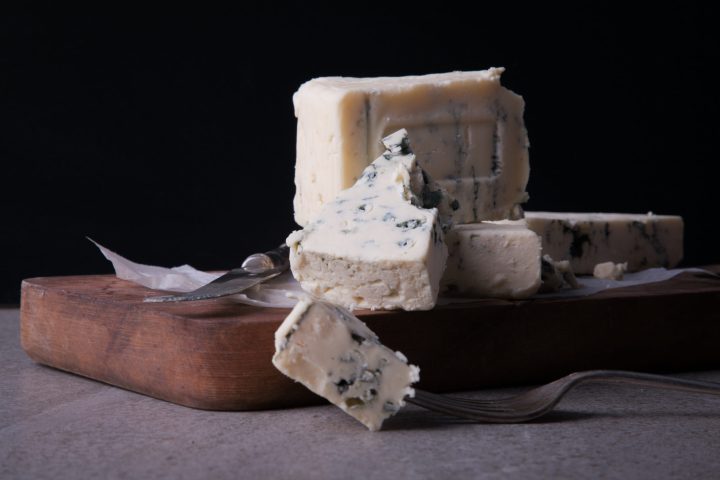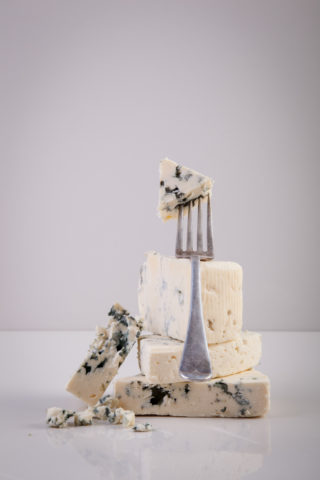MAIN INGREDIENT
True Blue: The strange allure of blue cheese

Veined with rivulets of blue mould, sometimes green, the cheeses we call ‘blue’ are an acquired taste. But once you’re hooked, it’s for life.
Blue cheese is for the adventurous, the daring, the devil-may-care. Not for the timid is blue cheese; the play-it-safe will keep away, retreating to the quiet, unchallenging places they prefer, the beige regions where everything is saccharine and any hue bolder than an earth tone is banished for fear it will offend the eye.
This column accompanies this recipe.
Blue. Veins. It’s off, it’s rotten, surely it’s past its sell-by-date, you might think if you had never heard of blue cheese and suddenly saw it and tasted it. What a strange thing blue cheese is, a foodstuff which has “reject” and “to be avoided” written all over it – literally, in those streaks of mould which you’d think would have any sane person heading for the hills – but no: we desire it, it is sought-after, prized. We seek it out, pay good money for it, call for seconds please. Gimme some more of that funky blue mouldy stuff.
There’s something about blue, my favourite colour. It must be the most versatile of hues, used idiomatically for everything from sadness and sickness (feeling blue/blue around the gills) to societal status (from blue blood for royalty to blue collar for working class), loyalty (true blue), pornography, anxiety (blue funk), being bruised (black and blue) and disappearing (into the blue). We can talk about it until we’re blue in the face, throw a blue fit or just put some cool blues on the turntable to lift our mood (or help us drown our sorrows).
Blue in the colour palette is lauded by designers, and often paired with golden hues, simply one of the best colour combinations there is. Blue on the palate, that’s something else.

(Photo: Louis Pieterse)
Blue cheese is a divider. Not everyone loves it, and some couldn’t even be bothered to try it so that they can taste what the fuss is all about and try to understand why it is that some of us adore the stuff. But some foods are like that. I’ve met so many people who have never put a fresh oyster to their lips, whose mouths curl in disgust at the mere mention of the word. Do they not know that it is like that for everyone before they’ve tasted it? At least give it a try, be brave, be bold. Come on, it’s your life and your palate can miss so many joys, so many delights, just because of a lack of courage to give it a go. Give us that much, those of us who do try many things and are often blessed to find a new delight, which we might never have had in our lives. If you don’t like it, well, that’s your indaba.
Anyway, anything that has a following of legions in every country on the planet surely must be worth investigating, if only once. Banish it from your life then if you will, but if you’re never going to put oyster or blue cheese, or fish sauce, to lip only because you THINK it is going to be foul is, well, a pretty foul approach to life and the living of it, if I may put it that way.
Like Thai fish sauce, it may sound horrible or even smell foul, but it’s when you use it in cooking that the adventurous palate sends a signal to the brain and something goes Ping! … Oh my, this tastes so good, what is that? And that’s when you’re hooked, for life.
And yes, blue cheese is one of those cheeses that can give the palate a strange sort of feeling, a tingling which may seem unpleasant but which passes very quickly. I’ve never found it offputting. Certain mature Cheddars can have a similar effect. Some people will be aghast on first experiencing that and tell everyone they know that they can’t eat cheese, sorry, “I’m allergic”. Well, then I must be allergic to many cheeses too. Of course, there are real allergies, I respect that, but I do wonder whether some of those who think they’re allergic to cheese are really just bothered by that sensation in their mouths.
And nobody’s saying that blue cheese, characterised as it is by the sheer strength of its flavour punch, needs to be tasted at its full tilt; that is, eaten raw, as it were. Blue cheese in a soup, or a cream sauce, can be used in small quantities yet still give its soup or sauce that unmistakable blue cheese flavour and quality.
Okay, I know, “he’ll eat anything”, as people have often said about me. But actually, I won’t eat something which is truly foul. As for reality TV shows such as I’m a Celebrity…Get me Out of Here, the British programme in which (usually faded, half-forgotten) celebrities are shipped off to Australia and dumped in a jungle encampment where they have to accept challenges such as being locked in a cage of scorpions and snakes and having goggas crawl into your mouths, or eating live grubs and slugs and spiders and worse, you can count me out. I want good things to find their way to my palate.
Good things like blue cheese. I remember the first time I tasted Pont-l’Évêque, thought to be the oldest of the ancient Norman cheeses still in production. It was like being reborn. It was astonishing. So intense, so superbly delicious, yet it smelt truly foul before putting it to tongue.
Our ancestors are thought to have encountered blue cheese by accident when they stored cheeses in caves in which the balance of moisture and temperature created the right environment for those cultures to be formed and grow. Who knows exactly what happened next, but we can imagine that somebody reached for some and tasted it, liked it, told all the others, and before you knew it it had become a thing, as we would say today.
Legend has it that Roquefort, the classic French blue-veined cheese, came about by chance when a boy who had been eating bread and ewes’ milk cheese saw a beautiful girl and went off in search of her. When he returned months later, Wikipedia tells us, penicillium Roqueforti (as we now know it) had turned his discarded cheese into the delight now sought out by every gourmand.
Gorgonzola is a variety for which I have a particular soft spot, especially a creamy one, and it ought to be against the law not to eat Stilton when visiting England. And while they are similar, and may look pretty much the same in some cases, they all have distinctive flavour profiles.
Put on some blues in the moody kitchen, turn the lights down low, cook up some blue cheese joy. You’ll need a glass of red wine or port with that, by the way. DM/TGIFood
To enquire about Tony Jackman’s book, foodSTUFF (Human & Rousseau) please email him at [email protected]
There’s much more from Tony Jackman and his food writing colleagues in his weekly TGIFood newsletter, delivered to your inbox every Friday. Subscribe here. Also visit the TGIFood platform, a repository of all of 0ur food writing.



 Become an Insider
Become an Insider
Many years ago, my wife went on a ferry shopping trip from England to France and brought back among other goodies a French cheese (as well as the customary wine and beer). When I opened the cardboard box in which it was encased, there was a plastic wrapping followed by a foil wrapping followed by a light paper wrapping. Inside was a cheese, which, when I sliced into it, was a delicate creamy colour with veins of blue. The odour left us reeling backward, with full knowledge now of the need for the many layers of encasement. I was the one brave enough to taste it, but oh my God, the taste! The taste!! I cannot remember the name but if only I could find myself in France again with that cheese, I would embrace the maker with joy. (And yes, the beer and wine and goodies were pretty good, too)
I’m the same with a Stilton cheese but if I don’t consume it in one sitting my wife throws the remainder away. This brings back lovely memories.